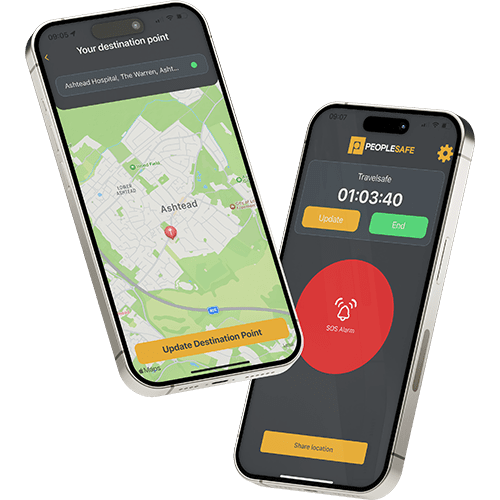Ensuring Employee Wellbeing in Hybrid Work Environments
The concept of the ‘workplace’ has undergone a transformation. For many, the ‘workplace’ now includes home and the office. According to the Chartered Institute of Personal Development (CIPD), 83% of organisations have a hybrid working model in place. This shift has been boosted by the Employment Relations (Flexible Working) Act of 2023, which grants employees greater autonomy in determining where, when, and how they work. And with nearly half of UK employees favouring a hybrid model, this shift is likely to remain.
The Challenges of Hybrid Working
However, the rise of hybrid work models has introduced new challenges for employers and employees, where the lines between home and office become increasingly blurred. While hybrid work offers flexibility and autonomy, it also presents a unique set of challenges that can impact personal safety and wellbeing.
For employers, hybrid working presents the challenge of maintaining a safe work environment, extending beyond traditional workspaces into the homes of remote workers. This dynamic adds the complexity of ensuring employee safety without the physical oversight typically provided in in-person settings.
Our latest research demonstrates the heightened concerns among hybrid workers with, 72% worried about their personal safety at work. For organisations, putting measures in place to support hybrid working while prioritising employee safety and wellbeing is a legal necessity that can also help them stand out from the crowd and attract top talent.

Legal Responsibilities
According to the Health and Safety at Work Act, it is the duty of every employer to ensure, so far as is reasonably practicable, the health safety and welfare of all their employees. This legislation applies no matter what ‘at work’ looks like. Therefore, an employee injured while working remotely due to employer negligence could qualify for compensation, if reasonable safety measures were not in place.
Reasonable safety measures while working from home could include ensuring that employees have ergonomic workstations, providing guidance on proper posture and regular breaks to prevent musculoskeletal issues, and implementing regular mental wellbeing check-ins throughout the day to ensure employees’ physical and psychological safety.
Benefits of Hybrid Working
Hybrid working offers an array of advantages for both employers and employees. One of the most significant benefits is better work-life balance. The flexibility offered by not commuting enables employees to better manage their personal and professional commitments, resulting in reduced stress levels and increased overall job satisfaction. Having more time for family and friends allows employees to switch off from work and enhance their personal wellbeing.
Hybrid working has also been shown to boost productivity levels. By allowing employees the flexibility to choose where they work, individuals can optimise their environments to minimise distractions and focus on tasks more effectively. Having the time to prioritise personal wellbeing and rest enables employees to come to work more well rested, boosting their output.
Cost savings are another compelling advantage of hybrid working, benefiting both employees and employers. Remote work eliminates expenses associated with commuting, work attire, and dining out for employees. Employers can reduce overhead costs by downsizing office space and minimising utility expenses. These cost savings can be redirected towards other business initiatives.
For businesses, hybrid working facilitates access to a broader talent pool. By removing geographical barriers to recruitment, organisations can hire the best candidates regardless of their location. This brings together individuals with diverse perspectives and skill sets. As a result, companies can drive innovation and creativity, gaining a competitive edge in the marketplace.
Considering these benefits, it’s clear that hybrid working can be beneficial for many organisations. However, it’s crucial for employers to carefully consider the safety and wellbeing implications that come with this shift.

The Impact of Hybrid Working on Employee Wellbeing
While a mix of home and on-site working is great for some, for others it can present a number of risk factors relating to stress, mental health and wellbeing. These include feelings of isolation, inadequate workstations, blurred mental and physical boundaries, disruptions to home life and the worry of being alone in an emergency. This is especially true for individuals facing difficult home situations like domestic abuse, as remote work can worsen their circumstances.
Hybrid workers who split their working time between home and another location face at home risks, as well as standard workday risks, including the commute to and from work. For many, travelling is when fears are higher than ever. Our research found that:
- 60% feel unsafe on public transport at off peak times
- 50% feel unsafe travelling alone to and from work
- 65% feel unsafe working in an unfamiliar location
These safety concerns not only impact employees in the moment but can also have lasting effects on employees’ mental health, further affecting their ability to perform effectively and increasing the risk of burnout. Constantly worrying about personal safety concerns can tip the balance for those struggling to maintain a healthy work-life balance and detach from work out of hours.
These widespread fears are leading to a growing expectation for employers to extend their duty of care beyond traditional working, with 51% of workers believing their employer has an inherent responsibility to protect them outside of working hours.
Yet businesses seem to be falling short in addressing the safety concerns of hybrid workers. Our research found that 72% of employees have safety concerns when hybrid working, showing that current protective measures are not enough to put employee’s minds at rest. The Health and Safety Executive (HSE) has provided post-pandemic guidelines for at-home and hybrid working scenarios. However, this guidance is not legislation, so carries no immediate legal consequences for employers.
Although there may be no clear legal consequences, failing to adhere to these guidelines can have a significant impact in other areas. Businesses may want to consider employee productivity, health and retainment as additional motivation, aside from the moral obligation to give hybrid worker wellbeing appropriate focus.
Improving Safety for Hybrid Workers
Ensuring the safety and wellbeing of hybrid workers requires a multifaceted approach that addresses the unique challenges and risks associated with remote and on-site work environments.
1. Implement Policies
To begin with, implementing comprehensive safety policies is crucial. These policies should be tailored to the needs of hybrid workers and cover various aspects such as ergonomic workstation assessments, emergency procedures, data protection and training for managers on overseeing hybrid workers. Clear guidelines provide a framework for employees to follow, reducing the likelihood of accidents or safety breaches.
2. Safety Training
Additionally, providing safety training and resources is essential. Offering specialised training programs can educate hybrid workers on best practices for mitigating safety risks in both remote and on-site settings. Training sessions may include topics like cyber security, personal safety, emergency response protocols, and mental health awareness. Equipping employees with the necessary knowledge and skills empowers them to prioritise their safety.
3. Promoting Open Communication
Promoting open communication is another key aspect of improving safety for hybrid workers. Establishing channels where employees feel comfortable reporting safety concerns, seeking support, and providing feedback fosters a culture of transparency and accountability. Regular check-ins with managers or HR representatives allow for the identification and resolution of safety or wellbeing issues.

4. Support Mental Health
Furthermore, supporting mental health is essential for employee wellbeing. Encouraging employees to prioritise self-care and disconnect from work outside of designated hours prevents burnout and promotes overall health. Setting clear expectations around working hours, breaks, and time off helps maintain a healthy balance between professional and personal responsibilities. You can also show your support for mental health by providing access to employee assistance programmes with access to support resources or by offering in-house support for employees who may be struggling.
5. Monitor workload
Monitoring workload is crucial for hybrid workers to maintain productivity and prevent burnout, to do this, employers can implement systems or software to track tasks and deadlines effectively. Regular check-ins and communication channels can also help managers gauge workload levels and provide necessary support or adjustments as needed.
6. Invest in Technology
Investing in technology can also enhance safety and communication for hybrid workers. Providing secure remote access to company systems, implementing safety monitoring tools, and facilitating virtual collaboration platforms ensure communication and collaboration across remote and in-office teams. Leveraging technology solutions helps to bridge the gap between central and remote work environments, enabling employees to work safely and efficiently.
Additionally, implementing personal safety technology can provide invaluable peace of mind for those working alone, in the workplace or at home. The service works by providing employees with a direct link to a dedicated control centre, available 24/7 to handle emergency situations, via a personal safety app or personal safety device.
Our latest solution, Travelsafe, addresses the risk of workers travelling by allowing employers to stay informed about their employees’ safety and confirming that they have arrived at their destination or back home safely at the end of the day.
The Future of Hybrid Work
As hybrid working continues to evolve, employers must remain vigilant and proactive in addressing emerging safety concerns and adapting to changing workplace dynamics. Moreover, as legislation changes to specifically protect people working from home are likely to come into place, it’s essential for employers to embrace innovation and new tools to boost organisational success and employee satisfaction. By staying proactive and adaptable, businesses can not only ensure compliance with future regulations but also foster a safer and more supportive work environment for all employees, regardless of their location.






